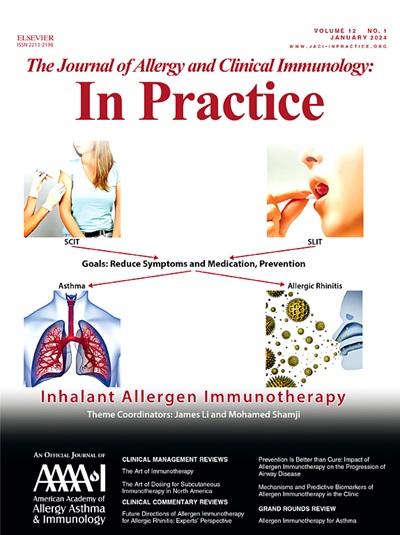Parameters Linked With Higher Itch Severity in Chronic Spontaneous Urticaria—Chronic Urticaria Registry Results
IF 6.6
1区 医学
Q1 ALLERGY
Journal of Allergy and Clinical Immunology-In Practice
Pub Date : 2025-09-01
DOI:10.1016/j.jaip.2025.05.033
引用次数: 0
Abstract
Background
Itch is the most bothersome symptom in chronic spontaneous urticaria (CSU) and severely affects quality of life.
Objective
To analyze factors associated with itch severity, and how itch is associated with quality of life and health care use in CSU.
Methods
We retrieved patient data from the Chronic Urticaria Registry. Patients were categorized by self-reported itch severity (recall period of 7 days). We used ordinal logistic regressions as well as negative binomial and gamma regressions with log link to investigate possible associations.
Results
A total of 3,045 patients, 74.3% female, mean age 44.4 years, with no, mild, moderate, or intense itch (16.4%, 25.2%, 32.5%, and 25.9%, respectively) were included. A higher itch rating was associated with symptomatic dermographism (odds ratio [OR] = 1.25; P = .027), malaise (OR = 1.43; P < .001), depression (OR = 1.46; P = .008), and laboratory signs of inflammation (ie, elevated erythrocyte sedimentation rate (OR = 1.57; P = .031) and leukocyte counts (OR = 2.37; P = .004)). Intense itch was associated with worse quality of life (Chronic Urticaria Quality of Life Questionnaire; P < .001) and more patients visiting a general practitioner, allergologist or dermatologist, and the emergency room (P < .001).
Conclusions
Higher itch levels are associated with inflammation and depression and are linked to worse quality of life and increased health care demand. Addressing itch is crucial to reducing the humanistic and societal burden in CSU.
慢性自发性荨麻疹中与较高瘙痒严重程度相关的参数- CURE结果。
背景:瘙痒是慢性自发性荨麻疹(CSU)患者最困扰的症状,严重影响患者的生活质量。目的:分析CSU患者瘙痒严重程度的相关因素,以及瘙痒与生活质量和医疗保健利用的关系。方法:从慢性荨麻疹登记处(CURE)检索患者数据。患者根据自己报告的瘙痒严重程度进行分类(回忆期:7天)。使用有序逻辑回归以及负二项回归和带对数链接的伽马回归来调查可能的关联。结果:共纳入无/轻度/中度/重度瘙痒患者3045例(16.4%/25.2%/32.5%/25.9%),其中女性:74.3%;平均年龄:44.4岁)。较高的瘙痒评分与症状性皮肤特征(OR: 1.25, p=0.027)、不适(OR: 1.43)相关。结论:较高的瘙痒评分与炎症和抑郁有关,与生活质量下降和医疗需求增加有关。解决瘙痒问题对于减轻CSU的人文和社会负担至关重要。
本文章由计算机程序翻译,如有差异,请以英文原文为准。
求助全文
约1分钟内获得全文
求助全文
来源期刊

Journal of Allergy and Clinical Immunology-In Practice
ALLERGYIMMUNOLOGY-IMMUNOLOGY
CiteScore
11.10
自引率
9.60%
发文量
683
审稿时长
50 days
期刊介绍:
JACI: In Practice is an official publication of the American Academy of Allergy, Asthma & Immunology (AAAAI). It is a companion title to The Journal of Allergy and Clinical Immunology, and it aims to provide timely clinical papers, case reports, and management recommendations to clinical allergists and other physicians dealing with allergic and immunologic diseases in their practice. The mission of JACI: In Practice is to offer valid and impactful information that supports evidence-based clinical decisions in the diagnosis and management of asthma, allergies, immunologic conditions, and related diseases.
This journal publishes articles on various conditions treated by allergist-immunologists, including food allergy, respiratory disorders (such as asthma, rhinitis, nasal polyps, sinusitis, cough, ABPA, and hypersensitivity pneumonitis), drug allergy, insect sting allergy, anaphylaxis, dermatologic disorders (such as atopic dermatitis, contact dermatitis, urticaria, angioedema, and HAE), immunodeficiency, autoinflammatory syndromes, eosinophilic disorders, and mast cell disorders.
The focus of the journal is on providing cutting-edge clinical information that practitioners can use in their everyday practice or to acquire new knowledge and skills for the benefit of their patients. However, mechanistic or translational studies without immediate or near future clinical relevance, as well as animal studies, are not within the scope of the journal.
 求助内容:
求助内容: 应助结果提醒方式:
应助结果提醒方式:


